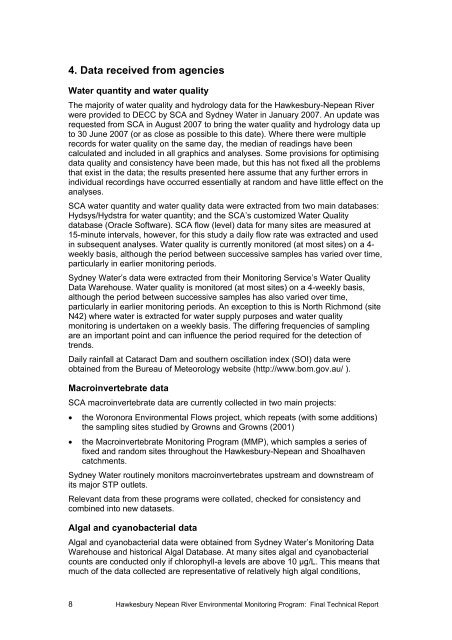Hawkesbury-Nepean River Environmental Monitoring Program
Hawkesbury-Nepean River Environmental Monitoring Program
Hawkesbury-Nepean River Environmental Monitoring Program
You also want an ePaper? Increase the reach of your titles
YUMPU automatically turns print PDFs into web optimized ePapers that Google loves.
4. Data received from agencies<br />
Water quantity and water quality<br />
The majority of water quality and hydrology data for the <strong>Hawkesbury</strong>-<strong>Nepean</strong> <strong>River</strong><br />
were provided to DECC by SCA and Sydney Water in January 2007. An update was<br />
requested from SCA in August 2007 to bring the water quality and hydrology data up<br />
to 30 June 2007 (or as close as possible to this date). Where there were multiple<br />
records for water quality on the same day, the median of readings have been<br />
calculated and included in all graphics and analyses. Some provisions for optimising<br />
data quality and consistency have been made, but this has not fixed all the problems<br />
that exist in the data; the results presented here assume that any further errors in<br />
individual recordings have occurred essentially at random and have little effect on the<br />
analyses.<br />
SCA water quantity and water quality data were extracted from two main databases:<br />
Hydsys/Hydstra for water quantity; and the SCA’s customized Water Quality<br />
database (Oracle Software). SCA flow (level) data for many sites are measured at<br />
15-minute intervals, however, for this study a daily flow rate was extracted and used<br />
in subsequent analyses. Water quality is currently monitored (at most sites) on a 4weekly<br />
basis, although the period between successive samples has varied over time,<br />
particularly in earlier monitoring periods.<br />
Sydney Water’s data were extracted from their <strong>Monitoring</strong> Service’s Water Quality<br />
Data Warehouse. Water quality is monitored (at most sites) on a 4-weekly basis,<br />
although the period between successive samples has also varied over time,<br />
particularly in earlier monitoring periods. An exception to this is North Richmond (site<br />
N42) where water is extracted for water supply purposes and water quality<br />
monitoring is undertaken on a weekly basis. The differing frequencies of sampling<br />
are an important point and can influence the period required for the detection of<br />
trends.<br />
Daily rainfall at Cataract Dam and southern oscillation index (SOI) data were<br />
obtained from the Bureau of Meteorology website (http://www.bom.gov.au/ ).<br />
Macroinvertebrate data<br />
SCA macroinvertebrate data are currently collected in two main projects:<br />
• the Woronora <strong>Environmental</strong> Flows project, which repeats (with some additions)<br />
the sampling sites studied by Growns and Growns (2001)<br />
• the Macroinvertebrate <strong>Monitoring</strong> <strong>Program</strong> (MMP), which samples a series of<br />
fixed and random sites throughout the <strong>Hawkesbury</strong>-<strong>Nepean</strong> and Shoalhaven<br />
catchments.<br />
Sydney Water routinely monitors macroinvertebrates upstream and downstream of<br />
its major STP outlets.<br />
Relevant data from these programs were collated, checked for consistency and<br />
combined into new datasets.<br />
Algal and cyanobacterial data<br />
Algal and cyanobacterial data were obtained from Sydney Water’s <strong>Monitoring</strong> Data<br />
Warehouse and historical Algal Database. At many sites algal and cyanobacterial<br />
counts are conducted only if chlorophyll-a levels are above 10 µg/L. This means that<br />
much of the data collected are representative of relatively high algal conditions,<br />
8 <strong>Hawkesbury</strong> <strong>Nepean</strong> <strong>River</strong> <strong>Environmental</strong> <strong>Monitoring</strong> <strong>Program</strong>: Final Technical Report
















